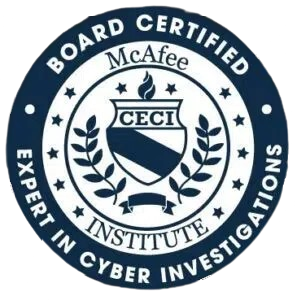If you’re interested in cryptocurrency tracing and how it works Read on!
Blockchain forensics and cryptocurrency tracing are tracking methods specialists use to decipher transactions on a pseudo-anonymous blockchain like Bitcoin’s.
The software tools cryptocurrency tracing experts use become more and more capable.
These tools turn the limited information the ledger provides into a visual trail of the illicit funds.
They may even identify the persons behind the transactions.
Cryptocurrency tracing and asset recovery specialists can also freeze and recover funds in cooperation with local law enforcement.
Cryptocurrency tracing plays an important role in defeating crimes like:
- Online fraud
- Hacking
- Theft
- Phishing schemes
- ExtortionCryptocurrency investigations aim to recover money people lose to crime and deception.The end goal of cryptocurrency tracing is always asset recovery.To get to that point, investigators must have real-life investigation skills and must be capable of liaising effectively with law enforcement around the world.The more advanced cryptocurrency tracing tools investigators use, the more likely they bring their tracing efforts to a satisfactory conclusion.
Blockchain analysis tools are ingenious software solutions that allow investigators to peer into the transactions on the blockchain and make sense of them.
Eventually, courtesy of these tools, they may even be able to match real-life entities to individual transactions and addresses.
What are the primary functions of a blockchain analysis tool?
- Transaction monitoring. Knowing the history of the funds, the money flow through an address, the origin of the funds, and other details can help investigators determine whether they are dealing with legitimate activity or fraud. It can also help them attach real-world identities to transactions and determine the likely intent behind them.
- Classifying addresses. Blockchain analysis tools classify addresses and establish connections with real-world people. Address classification is a basic step in crypto tracing, so tracing tools use several techniques to ensure they produce reliable, solid information in this respect.
- Visualization. Analysis tools compile the information they gather and deduce, into visually appealing graphs. Investigators can make connections based on these graphs and manually investigate the transactions that stand out.
As tracing tools grow more complex and effective, crypto criminals employ more and more refined tactics to hide the trail of the funds they steal.
In response, investigators deepen their research.
Thus, this cat-and-mouse game is like a virtual, crypto-focused arms race that continues to escalate.
Blockchain analysis tools can trace a range of relevant information on a pseudo-anonymous blockchain like Bitcoin.
Attribution Data
Collecting and processing attribution data can help investigators tie cryptocurrency transactions to various entities.
At this point in the tracing process, attribution data is not likely to yield direct associations between individuals and transactions.
It can, however, link transactions to groups, fraud rings, and schemes investigators may already know.
Attribution data may also allow investigators to identify fiat off-ramps the criminals may use or exchanges where they try to convert their coins into other cryptos or fiat money.
Monitoring scam databases is also a practice cryptocurrency investigators use to establish connections between transactions and criminal entities.
Web Scraping
Web scraping is a legitimate practice people use to make sense of large volumes of data on the internet.
They collect the data based on filters to ensure relevance.
They then process it and draw conclusions.
Cryptocurrency market analysts routinely use scraping to attempt to predict the movements of the markets.
Social media yields a trove of information and is a great target for scraping.
Cryptocurrency investigators can find and extract data from social media with the help of advanced tracing, scraping, and analysis tools.
Transaction Mapping
The mapping process is the visually most revealing part of the blockchain investigation.
It establishes links between entities and crypto addresses and traces transactions from their origins to their endpoints.
The visual examination of these flow charts and graphs allows investigators to recognize patterns and identify obfuscation techniques the thieves may use.
The charts offer visual clues on layering, peel chains, and other money laundering practices.
Although they use data available to the public through the blockchain, cryptocurrency tracing tools eliminate the manual labor from the data analysis.
It would be impossible to pore over the raw data manually and identify patterns.
Scam Database Monitoring and Prevention
Fraud monitoring refers to the constant surveillance of bank accounts and crypto addresses for suspicious changes and activities.
By monitoring scam databases and comparing the findings with suspicious activities through various crypto channels, investigators can discover relevant connections.
People can report crypto scams, rip-offs, and theft through various channels.
Many of the organizations behind these channels maintain exhaustive databases.
By monitoring these databases and suspicious activities on the blockchain and through crypto exchanges, investigators can link transactions to crime rings and even individuals.
Identifying Address Clusters
Cryptocurrency users can generate an almost infinite number of addresses.
And skilled criminals know how to take advantage of this peculiarity to obfuscate the trail of their activities.
That said, the patterns they leave on the blockchain can give investors a clue about the addresses individual criminals use.
By identifying behavioral and other patterns in transactions, investigators can expand the scope of their efforts to address clusters.
This way, they can collect more evidence and have a higher chance of connecting individuals to suspicious transactions.
Through cluster analysis, investigators can also determine whether the connected addresses have substantial value.
Common Spend and Address Reuse
Identifying instances of common spend is an interesting way of establishing connections among addresses.
Common spend happens when multiple small-value addresses “pool” their resources to finance a high-value transaction.
When investigators see such a transaction they automatically link the addresses as belonging to the same entity.
Reusing an address is a crypto amateur mistake.
Whenever someone reuses an address, the transactions compromise privacy.
The more transactions one completes on a single address, the easier it is for investigators to link that address to a specific person.
Establishing Targets for Subpoenas
This is a critical stage of the investigation process.
The crypto world is a mesh of individuals, exchanges, service providers, and other actors.
Many of these entities are regulated.
Those who value compliance observe Know Your Customer (KYC) and Anti-money Laundering (AML) rules.
They collect personal information on their users.
And when a criminal transfers crypto or fiat funds to an exchange, he/she leaves a trail.
Due to the data they collect on users, exchanges and crypto service providers are valuable targets for investigators.
If they obtain the subpoenas they need, they can lift the veil of anonymity from the suspicious transactions they are tracing.
Through exchanges, investigators may even find out the bank details of the criminals.
And, in cooperation with the authorities, freeze accounts to later recover funds.
IP Address Tracking
Once they have a crop of suspicious crypto addresses, capable investigators can use them as starting points to obtain more relevant information.
Advanced Bitcoin surveillance systems can run full nodes on the network and “listen” to the chatter of transactions.
They can identify IP addresses linked to suspicious addresses and transactions.
Once they do, based on these IP addresses, investigators can determine the geographic location of the entities using the suspicious Bitcoin addresses.
Reading into Total Transactions
Crypto tracing specialists can uncover the size of fraud by determining the volume of transactions it involves.
Larger frauds draw more attention from the authorities.
Law enforcement is more willing to assist when a crime entails several victims.
Wrapping up large-scale fraud sets the stage for class action lawsuits.
Automated Risk Profiling
When an experienced and skilled investigator looks at a Bitcoin address and the activity associated with it, he/she can tell if it’s suspicious.
Combing through millions of addresses manually is not realistic.
Advanced tracing tools can assign risk scores to addresses based on their calculations.
Investigators then only double-check the addresses the system flags.
Identifying High-value Addresses
The value of Bitcoin addresses may not seem particularly important in the tracing process, but it is highly relevant.
Not only does it help investigators trace funds through a web of transactions, but it also provides them with a juicy target for seizure.
After they wrap up a scam, investigators go into asset-recovery mode.
Seizing high-value Bitcoin addresses gains added importance at this stage of the investigation.
Many organizations advertise and peddle their crypto tracing and recovery prowess these days.
How do you recognize the best and most capable crypto-tracing service providers?
- A good tracing specialist uses powerful tools. Relying on one crypto tracing tool is not a problem. Those looking for optimal results make an extra effort, however, and use two or three tools. A tracing specialist may use CipherTrace. Another may use CipherTrace, Reactor, and Qlue. The second investigator may find connections the first one may miss.
- Serious tracing specialists provide you with an expert report. You can use this report to sue the perpetrators to recover your stolen assets. Cryptocurrency Tracing Certified Examiners can compile such expert reports.
- Good investigators can trace assets worldwide. Serious tracing organizations maintain international teams with specialists and analysts in every country. Crypto crime is borderless. So should be the efforts to stop it.
- Strong crypto tracing organizations have worldwide connections. Tracing cryptocurrencies online is the first part of the asset recovery effort. When they identify and locate the criminals, investigators must go after them in real life. They must have local information sources, whistleblowers, and liaising capabilities with law enforcement.
- Serious crypto investigators offer full client confidentiality. Professionals value confidentiality and respect their clients’ rights to it. They encrypt the data clients provide to aid the investigation and ensure that it does not fall into the wrong hands.
Cryptocurrency tracing may be an emerging industry, but it is already highly capable.
Expert teams can track down assets worldwide.
They identify perpetrators, freeze accounts, and seize the proceeds of crimes.
Crypto crooks can no longer enjoy the fruits of their devious activities.














